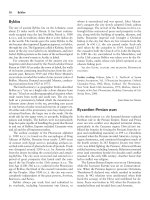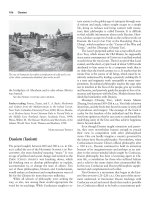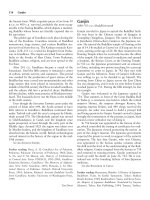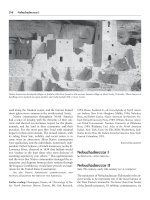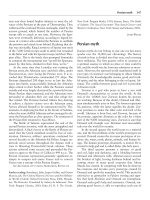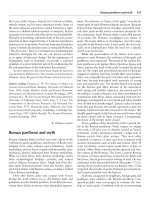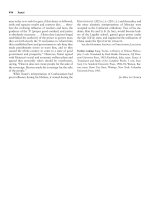Encyclopedia of world history (facts on file library of world history) 7 volume set ( PDFDrive ) 3235
Bạn đang xem bản rút gọn của tài liệu. Xem và tải ngay bản đầy đủ của tài liệu tại đây (64.88 KB, 1 trang )
Teresa of Calcutta, Mother
the 1990s and after, evidenced by a 1997 congressional
investigation into the massacre and the 2006 indictment of ex-president and then-interior minister Luis
Echevarría for his role in the events, which remain a
festering wound in the nation’s collective memory.
Further reading: Ecker, Ronald L. “The Tlatelolco Massacre
in Mexico.” www.hobrad.com/massacre.htm (cited February 2007); Poniatowska, Elena. Massacre in Mexico Translated by Helen R. Lane. Columbia: University of Missouri
Press, 1975.
Michael J. Schroeder
Teilhard de Chardin, Pierre
(1881–1955) scientist, mystic, writer
Pierre Teilhard de Chardin was one of the most eloquent 20th-century voices for religion in an increasingly secular world. As a distinguished paleontologist
and a Jesuit priest, he tried to synthesize evolutionary science with the incarnation of Christ. His ideas
were new, speculative, and bold enough to figure into
deliberations as diverse as the founding of the United Nations and the formulation of several Vatican
Council documents. Even today his name is cited for
a spiritual perspective on the convergence of human
communication due to the Internet.
He was born in France into a devout Catholic family of 11 children in 1881. His father was an intellectual and a farmer, and his mother was a great-grandniece of Voltaire. Teilhard’s father provided his son a
keen interest in science, and his mother an inclination
toward mysticism. He received a top-notch Jesuit education and entered their novitiate program by 1899. By
1911 he was ordained a priest after doing assignments
in England and Egypt. World War I interrupted further
studies in geology, and he saw action on the front lines.
His close calls with death prompted him to consider a
more speculative approach to science.
After the war he brilliantly defended his doctorate
at the Sorbonne in 1922. Soon thereafter he accepted
the chair of the geology department at the Institut
Catholique. From this platform he now began to publicize ideas about the synthesis of science and religion,
and the resulting controversy cost him his license at
the Institut and forced him abroad to do his research
and study.
For almost the rest of his career he lived abroad,
almost as in a self-imposed exile. Most of that time he
415
spent in China (1926–46), and there he collaborated
with the Chinese Geological Survey and helped to discover the Peking Man skull. He wrote his important
books, The Divine Milieu and The Human Phenomenon, during these years.
For one brief time after World War II he returned to
France, but the Jesuits refused to allow him to take an
academic position lest he receive more critical scrutiny.
He was banned from lecturing in public or publishing
his writings. He decided to go to New York in 1951.
Lonely and suffering, he died on Easter Sunday, 1955,
and is buried in a Jesuit cemetery there.
From a scientific point of view it is difficult to establish the methodology and provability of Teilhard’s ideas.
He has clearly advanced the fields of geology, stratigraphy, and paleontology, with a supreme competence
in the areas of China and the Far East. However, his
dominant interest and the source of his infamy was in
“anthropogenesis,” a new study focusing on the evolutionary position of humanity.
He proposed that evolution had entered a new
phase with the emergence of humanity, whereby complexity and consciousness converged and spiritualized evolution. The final development of humanity he
termed the “Omega Point,” and he connected this perfection with Christ.
In 1962 the Catholic Church issued a warning
against the uncritical acceptance of Teilhard’s theories,
though it did not question his scientific contributions or
his integrity of faith. The best way of categorizing his
unsystematized though eloquent speculation is as process theology, or perhaps even as a form of Christian
pantheism.
Further reading: King, Ursala. Spirit of Fire: The Life and
Vision of Teilhard de Chardin. Maryknoll, NY: Orbis, 1996.
Teilhard de Chardin, Pierre. The Human Phenomenon.
Brighton, UK and Portland, OR: Sussex Academic Press,
1999;
Mark F. Whitter
Teresa of Calcutta, Mother
(1910–1997) Albanian religious leader
Small of stature but solid in fortitude, Mother Teresa
was born on August 26, 1910, in Skopje, Albania. The
youngest of the children of Nikola and Dran Bojaxhiu, she was baptized Gonxha Agnes. Her father’s sudden death when Gonxha was eight left the family in

